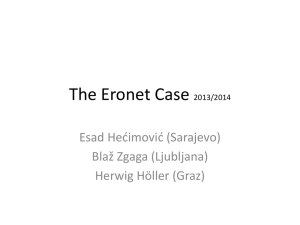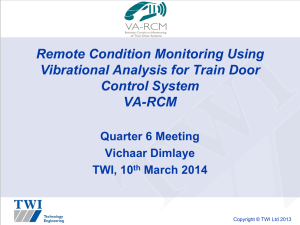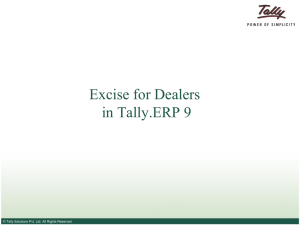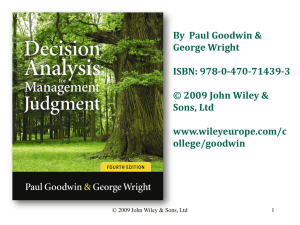AS-18 Related Party Disclosures
advertisement
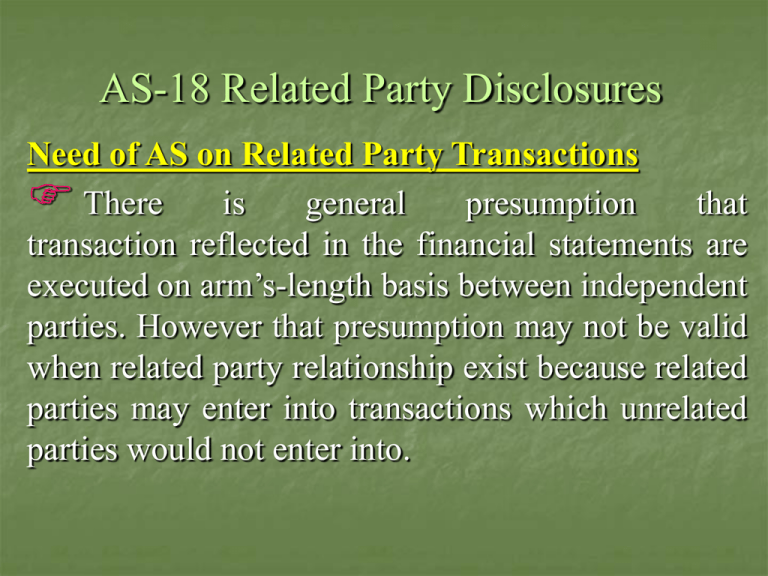
AS-18 Related Party Disclosures Need of AS on Related Party Transactions There is general presumption that transaction reflected in the financial statements are executed on arm’s-length basis between independent parties. However that presumption may not be valid when related party relationship exist because related parties may enter into transactions which unrelated parties would not enter into. AS-18 Related Party Disclosures Need of AS on Related Party Transactions Several related companies may have been developed to fulfill the desires of bad management. e.g. Companies formed to evade taxes, Companies formed to avoid labour laws, Companies formed to siphon funds AS-18 Related Party Disclosures Objective of AS-18 Objective of AS-18 is to establish the requirement for disclosures of Related Party Relationships Transactions between a reporting enterprise & its related parties. Definitions under AS-18 Related Party: Parties are considered to be related if at any time during the reporting period one party has the ability to control the other party or exercise significant influence over the other party in making financial and/or operating decisions. Control a) Ownership, directly or indirectly, of more than one half of the voting power of an enterprise, or b) Control of the composition of the board of directors in the case of a company or of the composition of the corresponding governing body in case of any other enterprise, or c) A substantial interest in voting power and the power to direct, by statute or agreement, the financial and/or operating policies of the enterprise. Significant Influence Significant Influenceparticipation in the financial and/or operating policy decisions of an enterprise, but not control of those policies. Significant Influence Significant influence can be exercised in several ways, e.g. By representation on the board of directors participation in the policy making process material inter-company transactions dependence on technical information if an investing party holds, directly or indirectly through intermediaries 20 % or more of the voting power of the enterprise. (rebut table presumption) AS-18 deals only with related party relationships described in (a) to (e) below: a) Enterprises that directly, or indirectly through one or more intermediaries control or controlled by or under common control with the reporting enterprise b) Associates, and joint ventures of the reporting enterprise and the investing party or venturer in respect of which the reporting enterprise is an associate or a joint venture; c) Individual owning, directly or indirectly, an interest in the voting power of the reporting enterprise that gives them control or significant influence over the enterprise, and relatives of any such individual; d) e) Key management personnel and relatives of such personnel; and Enterprises over which any person described in (c) or (d) is able to exercise significant influence. This includes enterprises owned by directors or major shareholders of the reporting enterprise and enterprises that have a member of key management in common with the reporting enterprise. Para-3 a) Enterprises that directly, or indirectly through one or more intermediaries control or controlled by or under common control with the reporting enterprise Holding company: a company having one or more subsidiaries. Subsidiary: a company: a) In which another company (the holding company) holds, either by itself and/or through one or more subsidiaries, more than one half in the nominal value of its equity share capital; or b) Of which another company (the holding company) controls, either by itself and /or through one or more subsidiaries, the composition of its board of directors. Fellow Subsidiary- a company is considered to be a fellow subsidiary of another company if both are subsidiaries of the same holding company. A Ltd. 60% B Ltd. 75% C Ltd. Fellow Subsidiaries Para-3 b) Associates, and joint ventures of the reporting enterprise and the investing party or venturer in respect of which the reporting enterprise is an associate or a joint venture; Para-10 Associate: an enterprise in which an investing reporting party has significant influence and which is neither a subsidiary nor a joint venture of that party. A Joint Venture: a contractual agreement whereby two or more parties undertake an economic activity which is subject to joint control. Para 3 c) Individual owning, directly or indirectly, an interest in the voting power of the reporting enterprise that gives them control or significant influence over the enterprise, and relatives of any such individual; Relatives Para 10 of AS-18 Relative- in relation to an individual, means the spouse, son, daughter, brother, sister, father and mother who may be expected to influence, or be influenced by, that individual in his/her dealings with the reporting enterprise. Relatives under the Companies Act,1956 1. Members of HUF 2. Husband and Wife 3. Related as per Schedule 1-A of the Companies Act, 1956 - brother (including step brother) and brother’s wife - Sister (including step sister) and Sister’s Husband - Father and Mother including step mother - Son (Including step son) and son’s wife - daughter (including step daughter) and daughter’s husband -Paternal and Maternal grandfathers and grandmothers - Grand children through either son or daughter and their spouses Relatives under the Companies Bill, 2008 “relative” with reference to any individual means the spouse, brother, sister and all lineal ascendants and descendants of such individual related to him either by marriage or adoption. Relatives under the Income Tax Act, 1961 “Relative” in relation to an individual, means the husband, wife, brother or sister or any lineal ascendant or descendant of that individual Relative under Para 9 of IAS-24 Close members of the family of an individual are those family members who may be expected to influence or be influenced by, that individual in their dealings with the entity. Para 3 (d) Key management personnel and relatives of such personnel; Para 10 of AS-18 defines KMP Key Management Personnel- those persons who have the authority and responsibility for planning, directing and controlling the activities of the reporting enterprise. Examples of Key Management Personnel (Para 14 of AS 18) In the case of company Managing Director (s) Whole time director (s) Manager Any person in accordance with whose directions or instructions the board of directors of the company is accustomed to act. Whether Non-Executive Directors on the Board are related parties? (ASI 21) A non executive director of a company should not be considered as key management person under AS 18 by virtue of merely his being director unless he has the authority and responsibility for planning, directing and controlling the activities of the reporting enterprise. The requirements of AS 18 should not be applied unless he falls in any of categories of para3 of AS18. Para 3 e) Enterprises over which any person described in (c) or (d) is able to exercise significant influence. This includes enterprises owned by directors or major shareholders of the reporting enterprise and enterprises that have a member of key management in common with the reporting enterprise. Related party transaction Para 10 of AS 18 defines Related Party Transactions- a transfer of resources or obligations between related parties, regardless of whether or not price is charged. Examples of Related Party Transactions: 1. Purchase or Sale of Goods 2. Purchase or Sale of Fixed Assets 3. Rendering or receiving of services. Examples of Related Party Transactions: 4. 5. 6. 7. Leasing or Hire Purchase Agreements Transfer of Research and Development Financing Transaction Management services provided by one company to another. 8. Group Branding or advertising without any cost. 9. Use of common infrastructures such as premises, vehicles, etc. without any cost. Practical Case Studies A Ltd. Holds control over X Ltd and exercises significant influence over Y Ltd and Z Ltd. In this situation X Ltd. Y Ltd. & Z Ltd. are related to A Ltd and vice versa. Whether X Ltd, Y Ltd & Z Ltd. are related to each other? What will be difference in your answer if Mr. S is able to exercise significant influence on a group of enterprise? No, Because para3 (a) of AS 18 includes the relationship between A Ltd with X Ltd, Y Ltd & Z Ltd but not between X Ltd, Y Ltd & Z Ltd. Further Para3(b) includes the relationship between an enterprise and its associate but does not include as related parties various associates of the same enterprise. In Second Case if Mr. S (i.e. individual) is able to exercise the significant influence on a group of enterprises, all those enterprises will be related party under para3(e) of AS 18 Practical Case Studies X Ltd holds 25% in Y Ltd and Y Ltd holds 30% in Z Ltd, whether X Ltd and Z Ltd are related parties? i.e. Whether associate of an associate is a related party? They are not related parties under 3(b). However, whether X Ltd and Z Ltd are related parties under para3(e) of AS 18 needs to be evaluated. Whether remuneration paid to Key Management Personnel is related party transaction? ASI 23 Yes, It is related party transaction requiring disclosures under AS 18. Disclosures: Para 21 Name of the related party and nature of the related party relationship where control exists should be disclosed irrespective of whether or not there have been any transactions between the related parties. Disclosures: If there have been transactions between related parties, during the existence of a related party relationship, the reporting enterprise should disclose the following: i. The name of the transacting related party; ii. A description of the relationship between the parties iii. A description of the nature of the transactions; iv. Volume of the transactions either as an amount or as an appropriate proportion v. Any other elements of the related party transactions necessary for an understanding of the financial statements; vi. The amount or appropriate proportions of outstanding items pertaining to related parties at Balance Sheet date and provisions for the doubtful debts due from such parties at that date vii. Amount written off or written back in the period in respect of debts due from or to the related parties.


